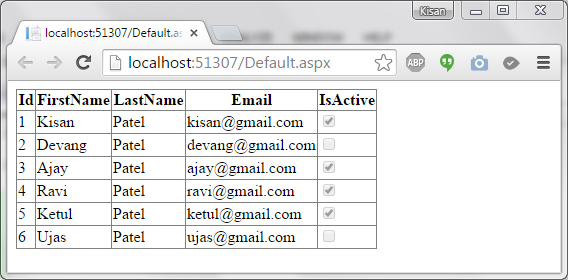Updated on Kisan Patel
This tutorial will show you how to populate gridview from code behind in ASP.NET with example.
Default.aspx
<asp:GridView ID="GridView1" runat="server" />
In the above code, we have declared a GridView without any associated properties.
Default.aspx.cs
protected void Page_Load(object sender, EventArgs e)
{
if (!IsPostBack)
{
GetData();
}
}
private void GetData()
{
DataTable table = new DataTable();
// get the connection
using (SqlConnection conn = new SqlConnection(ConfigurationManager.ConnectionStrings["DefaultConnection"].ConnectionString))
{
// write the sql statement to execute
string sql = "SELECT Id, FirstName, LastName, Email, IsActive FROM Students";
// instantiate the command object to fire
using (SqlCommand cmd = new SqlCommand(sql, conn))
{
// get the adapter object and attach the command object to it
using (SqlDataAdapter sdt = new SqlDataAdapter(cmd))
{
// fire Fill method to fetch the data and fill into DataTable
sdt.Fill(table);
}
}
}
// specify the data source for the GridView
GridView1.DataSource = table;
// bind the data now
GridView1.DataBind();
}
In the code behind, we have used ADO.NET objects to retrieve the data from the database to a DataTable and that DataTable (table variable) is being used as the DataSource for the GridView. then, we need to call the DataBind method of the GridView that actually binds the data to the GridView.
Demo
